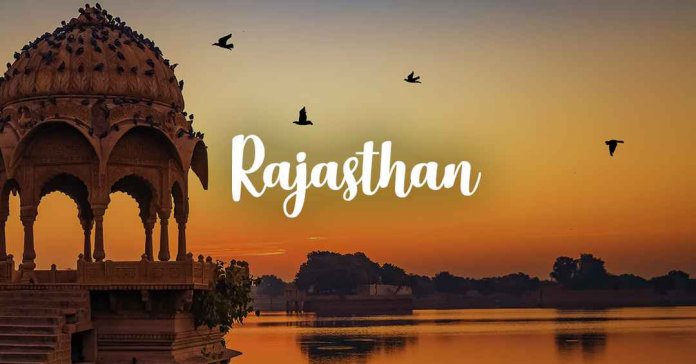This disquisition deals with the land of maharajas and home to numerous medieval forts and palaces. Rajasthan is a colourful blend of various fascinating traditions, peculiar scent of the old world charm, and the exquisiteness of the architecture.
Rajasthan diwas – 30 March
Where is India’s only saline river flow? In which state of India, one of the world’s most luxurious trains is?
Now let’s explore the opulent, grand, vibrant and warm shades of Rajasthan.
Rajasthan: The word itself defines ‘Raja-sthan’ which means the place where the kings reside. It is the land of mighty Kings and valiant warriors, Mirabai, Thar Desert, Ranthambore National Park, forts, palaces and intricately woven folklore and fairy tales.
Before jumping to the aspects of Rajasthan, let’s have a look over the state symbols.
Table of Contents
STATE SYMBOLS OF RAJASTHAN:
| State Capital | Jaipur |
| State Flower | Tecomella |
| State Tree | Jand |
| State Animal | Camel |
| State Bird | Great Indian Bustard |
| State Dance | Ghoomar |
| State Governor (PRESENT) | Kalraj Mishra |
| State Chief Minister (PRESENT) | Ashok Gehlot |
Let’s move forward and study the topmost aspect of Rajasthan i.e. Culture.
Rajasthan Culture Notes:
Rajasthan’s Culture dates back to the years of Kings where it was previously called Rajputana. ‘Atithi Devo bhava’ means to treat your guests as God. This principle is a part of the Rajasthani Culture. Rajasthan is a vast state with the insight of the Rajasthani folk and their culture. The state has been blessed with such historical and beautiful forts and other monuments.
- Manganiyars and Langas are two prominent groups that contributed to Rajasthan folk music.
- Ghoomer dance originated in Udaipur that has gained international recognition and appreciation. Some of the dances include chang, bhopa, tejali, and kathipuli.
- Rajasthani food is known for its various spices and its sweetness. Rajasthan is most famous for dalbati churma, kachori both sweet and spicy. Ghewar and gheriya are some delectable sweet dishes originating from Mewar, Rajasthan. Non-vegetarian dishes like Lal Maas and Mohan Maas are delicacies in Rajasthani cuisine.
- The architectural style in Rajasthan is very diverse. The fort contains several gates, Jain temples and Havelis which is included as a world heritage site by UNESCO.
- There has been a strong influence of religion on Rajasthan. Most residents of Rajasthan are Hindus, Muslims, and Jains. There are various temples that are important pilgrim sites like the Lodrakar and Ranakpur Jain Temple, Jagdish temple, etc.
- Camels are commonly found animals in Rajasthan. Camel fairs take place every year in Bikaner, Pushkar and other regions. It is a festival dedicated to the ship of the desert and their owners. There are various events and competitions carried out for fun like camel race and camel dance.
- Some dialects originating from Rajasthan include Marwari, Malvi, Mevati, Jaipuri/Dhundari out of which the most famous is Marwari.
- The official language of Rajasthan is Hindi.
Now, let’s talk about the geography of the state.
Rajasthan Geography Notes:
Rajasthan is a state in the northwestern part of the Indian subcontinent. Rajasthan is the largest state in the Republic of India by area. The capital city is Jaipur situated in the east-central part of the state.
- Latitudinal Extension – 23°30’ N and 30°11’ N
- Longitudinal Extension – 69°29’ E and 78°17’ E
- Area – 342,239km2
Rank in India – 1st
- Population – 68,548,437
Rank in India – 7th
- It is bounded to the north and northeast by Punjab and Haryana, to the east and southeast by Uttar Pradesh and Madhya Pradesh, to the southwest by Gujarat.
- The state shares its north-western and western boundary with the Indo-Pakistan international border that extends about 1,070 km and touches the major districts Barmer, Bikaner, Ganganagar and Jaisalmer.
- The oldest chain of fold mountains i.e. the Aravali Range splits the state into two geographical zones- desert at one side and forest belt on the other. Those are the two natural divisions of Rajasthan.
- Only 9.36% of the total geographical region lies under forest vegetation in the state.
- The Thar Desert or the Great Indian Desert or Maru-kantar encompasses about 70% of the total landmass of Rajasthan and hence the state is identified as the ‘Desert State of India’.
Climate:
Rajasthan has a wide range of climate that varies from extremely arid to humid. The humid zone spans the southeast and east. The climate of Rajasthan can be broadly classified into four distinct seasons. Namely, Pre-monsoon is the hot season preceding the monsoon and extends from April to June, the Monsoon occurs in the month of June in the eastern region and mid- July in the western arid regions, the Post-monsoon commences from mid-September and continues till November and the Winter extends from December to March, January being the coldest month of the year. The average temperature in winter ranges from 8° to 28° C and the average temperature in summer ranges from 25° to 46° C.
Soil type:
The soils of the state have been divided into 7 groups on the basis of their occurrence, chief characteristics and suitability for cultivation. These soil types are: desert soil, grey and brown soil, red and yellow soil, ferruginous red soil, mixed red and black soil, medium black soil, and alluvial soils. In many parts of the state, soils are saline or alkaline.
Now, let’s discuss the political aspects of Rajasthan.
Rajasthan GOVERNMENT AND POLITICS Notes:
The structure of Rajasthan’s government is like that of most other states in India is determined by the national constitution of 1950. The head of state is the governor, who is appointed by the president of India. The governor is aided and advised by the Council of Ministers, which is headed by a chief minister. The state is divided into 33 districts. In each district, the district magistrate is the principal representative of the administration. For administrative purposes, each district is split into a few subdivisions which are divided into tehsils, which contain a number of villages.
Representation of Rajasthan in Parliament:
Assembly seats (unicameral): 200
Rajya Sabha: 10
Lok Sabha: 25
First Governor of Rajasthan: Maharaja Man Singh II
First Chief Minister of Rajasthan: Heera Lal Shastri
Some Interesting Facts About Rajasthan:
- Luni River originates in the Pushkar Valley and flows through the Thar Desert to meet its final destination in the marshy lands of Kutch. The river got its name from the Sanskrit word Lavanvati, which means Salt River. The river is India’s only saline river.
- One of the most luxurious trains in India, ‘The Palace on Wheels’ was initiated in 1982 by the Indian Railways and Rajasthan tourism development corporation. The concept and design of this train are based on the royal culture and customs of Rajasthan. The train has 23 coaches with a total capacity of 104 persons.
- Jantar Mantar of Jaipur comprises the largest stone sundial of the world.
- The vibrant state of Rajasthan is home to 8 UNESCO World Heritage sites namely Chittorgarh Fort, Kumbhalgarh Fort, Ranthambore Fort, Gagron Fort, Amber Fort, Jaisalmer Fort, Keoladeo National Park, and Jantar Mantar.
- One of the most amazing facts about Rajasthan is that a few of its major cities are color-coded. Jaipur is called the Pink City as the Maharaja Sawai Ram Singh passed a law in 1876 asking residents to paint their houses pink to welcome the Prince of Wales and Queen Victoria. The blue colored houses in Jodhpur once signified the residence of Brahmins, later turned to be the color of the city. The stories of Jaisalmer are glorified by the name of Golden City which seeks its inspiration from the color of Thar Desert.
Hope this blog made most of your doubts clear about Rajasthan. In our forthcoming blog, we will be studying about other important aspects of Rajasthan.
What are the economic aspects of Rajasthan? Which palace of India accounts to have the longest fortification in the world?
In the next blog, the facets correlated with these questions will be answered certainly. If you don’t want to miss it, click here – Know your State ‘Rajasthan’ – Part 2. We hope it will help you in the preparation of your exams such SSC 10+2, SSC CGL, CDS, NDA, etc.
Also Check Punjab History Notes, Know your Haryana Free Pdf
Thank you




